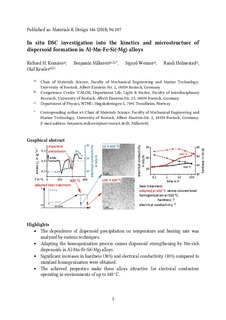| dc.contributor.author | Undheim, Espen | |
| dc.contributor.author | Maeda, Kensaku | |
| dc.contributor.author | Arnberg, Lars | |
| dc.contributor.author | Holmestad, Randi | |
| dc.contributor.author | Fujiwara, Kozo | |
| dc.contributor.author | Di Sabatino Lundberg, Marisa | |
| dc.date.accessioned | 2019-06-12T15:00:58Z | |
| dc.date.available | 2019-06-12T15:00:58Z | |
| dc.date.created | 2018-01-16T12:45:05Z | |
| dc.date.issued | 2018 | |
| dc.identifier.citation | Journal of Crystal Growth. 2018, 482 75-84. | nb_NO |
| dc.identifier.issn | 0022-0248 | |
| dc.identifier.uri | http://hdl.handle.net/11250/2600664 | |
| dc.description.abstract | The growth of silicon on various nitride coated quartz substrates were studied using in-situ observation of the solidification process. Three different coating types were used: One consisting entirely of α-Si3N4 particles, one of only β-Si3N4 particles, and a third of a 50/50 mixture of the above mentioned coating powders. The mean particle size of the α- and β-particles was about 0.3 μm and 5.7 μm, respectively. Three different cooling rates were used for each coating type: 2, 5 and 10 K/min. It was observed that the samples were similar at the lowest cooling rate, but at 5 K/min and higher the samples differed significantly. The biggest difference was seen in the α-particle coating, which showed significant dendritic growth, compared to the more faceted growth observed from the other coatings. All coatings containing the β-particles showed similar growth characteristics. These samples were also analyzed by electron-backscattered diffraction (EBSD) on both the vertical and horizontal planes. No clear trend in preferred crystal orientations was observed; however, it was seen that the density of Σ3 boundaries, especially parallel twins, increased with cooling rate. A gradual increase in the Σ3 grain boundary density was seen for the coatings containing β-Si3N4 particles, while the α-particle coating showed a faster increase. The grain sizes were also analyzed from the horizontal EBSD maps. Again there was a clear difference between the samples containing β-particles and the sample with α-particle coating. The ones containing β-particles showed a decrease in grain size with increasing cooling rate, while the opposite was true for the other α-particle coated samples. This was attributed to the rapid dendritic growth, which caused the grain structure to be dominated by one single grain. The difference in growth for the three coating types was explained using the athermal nucleation theory, which states that there is a correlation between particle sizes and nucleation undercooling. | nb_NO |
| dc.language.iso | eng | nb_NO |
| dc.publisher | Elsevier | nb_NO |
| dc.rights | Attribution-NonCommercial-NoDerivatives 4.0 Internasjonal | * |
| dc.rights.uri | http://creativecommons.org/licenses/by-nc-nd/4.0/deed.no | * |
| dc.title | In-situ studies of multicrystalline silicon nucleation and growth on alpha- and beta-Si3N4 coated substrates | nb_NO |
| dc.type | Journal article | nb_NO |
| dc.type | Peer reviewed | nb_NO |
| dc.description.version | acceptedVersion | nb_NO |
| dc.source.pagenumber | 75-84 | nb_NO |
| dc.source.volume | 482 | nb_NO |
| dc.source.journal | Journal of Crystal Growth | nb_NO |
| dc.identifier.doi | 10.1016/j.jcrysgro.2017.11.005 | |
| dc.identifier.cristin | 1544062 | |
| dc.relation.project | Norges forskningsråd: 245963 | nb_NO |
| dc.relation.project | Norges forskningsråd: 197405 | nb_NO |
| dc.description.localcode | © 2018. This is the authors’ accepted and refereed manuscript to the article. Locked until 4.11.2019 due to copyright restrictions. This manuscript version is made available under the CC-BY-NC-ND 4.0 license http://creativecommons.org/licenses/by-nc-nd/4.0/ | nb_NO |
| cristin.unitcode | 194,66,35,0 | |
| cristin.unitcode | 194,66,20,0 | |
| cristin.unitname | Institutt for materialteknologi | |
| cristin.unitname | Institutt for fysikk | |
| cristin.ispublished | true | |
| cristin.fulltext | preprint | |
| cristin.qualitycode | 1 | |

